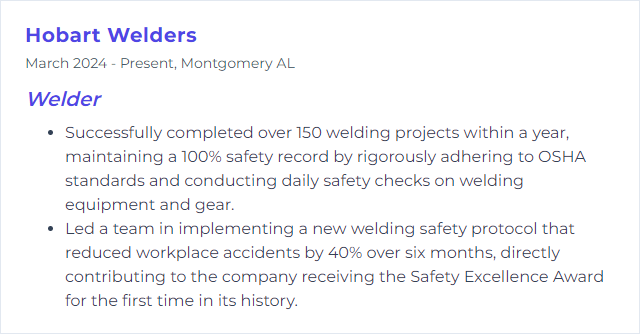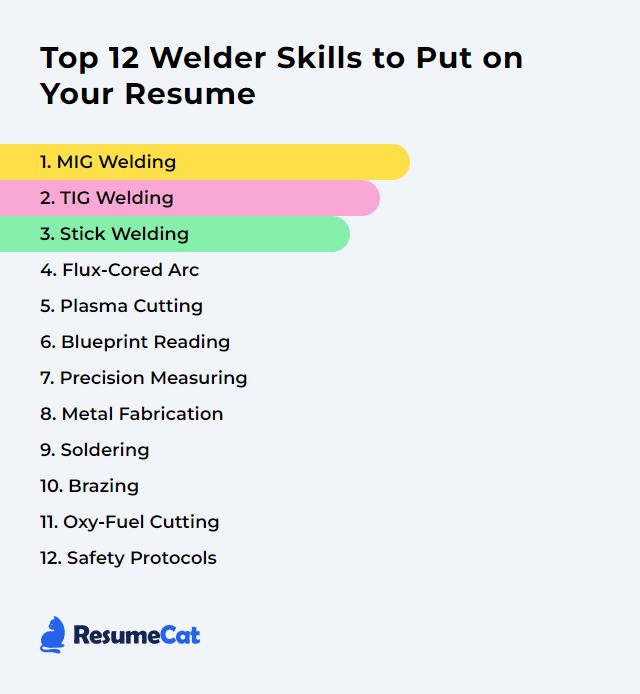Top 12 Welder Skills to Put on Your Resume
In today’s competitive job market, a standout resume matters. Welders who clearly present their strongest skills win interviews, faster. Show the core processes, the precision habits, and your commitment to safety. Make it obvious you can adapt, move quickly, and deliver clean, reliable work.
Welder Skills
- MIG Welding
- TIG Welding
- Stick Welding
- Flux-Cored Arc Welding (FCAW)
- Plasma Cutting
- Blueprint Reading
- Precision Measuring
- Metal Fabrication
- Soldering
- Brazing
- Oxy-Fuel Cutting
- Safety Protocols
1. MIG Welding
MIG welding, also known as Gas Metal Arc Welding (GMAW), feeds a continuous wire through a gun while shielding gas protects the puddle. Quick. Forgiving. Great for steel, stainless, and aluminum with the right wire and gas mix.
Why It's Important
MIG delivers speed and consistency on a wide range of materials and thicknesses. It’s production-friendly and approachable, yet capable of strong, clean welds when tuned correctly.
How to Improve MIG Welding Skills
Dial in voltage, wire feed, and inductance to match thickness and position. Keep the base metal spotless. Watch stickout (typically 3/8–1/2 inch) and maintain a steady travel speed. Use the correct shielding gas and wire for the job. Inspect liners, drive rolls, and contact tips often. Push technique for better gas coverage on most materials; pull when you need deeper penetration and don’t mind more spatter.
How to Display MIG Welding Skills on Your Resume
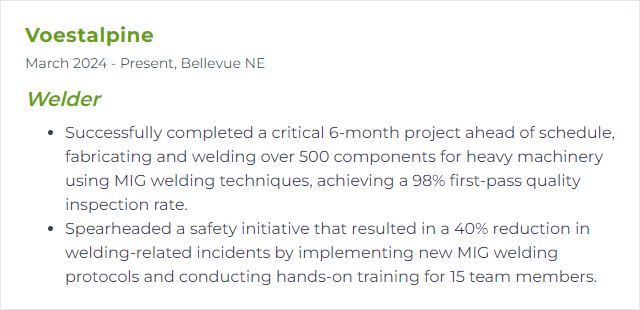
2. TIG Welding
TIG welding, or Gas Tungsten Arc Welding (GTAW), uses a non-consumable tungsten electrode and inert gas shielding. Fine control. Beautiful beads. Thin materials and specialty alloys shine here.
Why It's Important
TIG offers precision, minimal spatter, and excellent aesthetics. When tolerances get tight or the metal gets thin, TIG is the scalpel.
How to Improve TIG Welding Skills
Master heat control with foot pedal or fingertip amperage. Keep a tight, consistent arc length. Match tungsten type and size to current and material. Clean base metal thoroughly and use the right filler. Steady your hands with a brace, practice torch angles, and work all positions. Review your beads for uniformity, penetration, and color (especially on stainless and titanium).
How to Display TIG Welding Skills on Your Resume
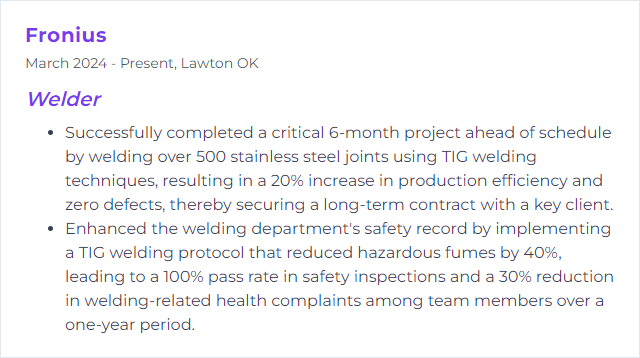
3. Stick Welding
Stick welding, or Shielded Metal Arc Welding (SMAW), uses flux-coated electrodes and works well outdoors or in less-than-ideal conditions. Rugged. Portable. Proven.
Why It's Important
It handles dirty or rusty steel, wind, and tight spots. Field repairs, structural work, heavy plate—stick gets it done.
How to Improve Stick Welding Skills
Select the right rod for the joint and position (e.g., 6010 for root passes, 7018 for low-hydrogen strength). Set amperage by electrode diameter and adjust for puddle control. Hold a slight drag angle, keep arc length short, and move with a steady rhythm. Clean the joint area and remove slag between passes. Practice vertical and overhead until your muscle memory sticks.
How to Display Stick Welding Skills on Your Resume
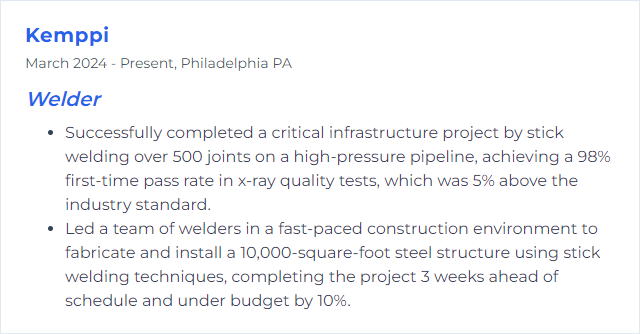
4. Flux-Cored Arc Welding (FCAW)
FCAW uses a tubular wire with flux inside. With gas (dual shield) or without (self-shielded), it lays down metal fast—great for thicker materials and out-of-position work.
Why It's Important
High deposition rates, strong penetration, and versatility in the shop or the field. Productivity climbs without sacrificing quality.
How to Improve Flux-Cored Arc Skills
Match wire type and diameter to the job (e.g., E71T-1 for versatility). Set voltage and wire feed from the spec sheet, then fine-tune while watching bead shape and sound. Maintain proper gun angle (about 15–45 degrees), travel speed, and stickout. Keep liners, contact tips, and drive rolls in peak condition. Clean the joint area, control interpass temperatures, and manage slag removal between passes.
How to Display Flux-Cored Arc Skills on Your Resume

5. Plasma Cutting
Plasma cutting drives an ionized gas jet through conductive metals for fast, precise cuts with limited heat-affected zones. Steel, stainless, aluminum—clean kerfs, quick setups.
Why It's Important
Accurate parts save fit-up time and reduce grinding. Less distortion means better assemblies and fewer reworks.
How to Improve Plasma Cutting Skills
Use the right consumables and change them before quality slips. Set amperage and air pressure per material and thickness. Maintain proper torch-to-work distance and pierce height. Tune travel speed to minimize dross and bevel. For long straight cuts, ride a guide or use a CNC table. Always protect eyes, skin, hearing, and lungs—plasma is bright and loud.
How to Display Plasma Cutting Skills on Your Resume
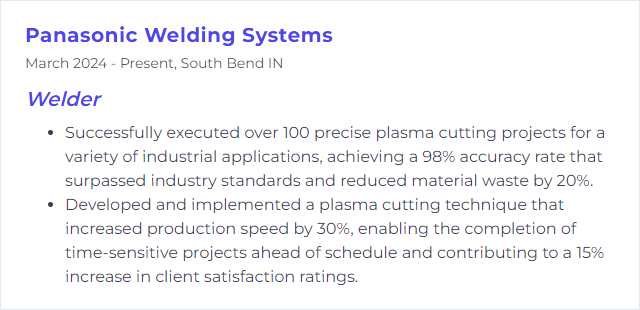
6. Blueprint Reading
Blueprint reading means decoding drawings, weld symbols, tolerances, notes, and materials to build exactly what’s intended. No guesswork. No surprises.
Why It's Important
You align fabrication with design requirements. That protects fit, function, and code compliance.
How to Improve Blueprint Reading Skills
Learn standard weld symbols and joint types thoroughly. Practice interpreting views, sections, and GD&T basics. Read title blocks, revision histories, and material callouts. Spend time with sample prints and verify measurements on real parts. If available, explore CAD viewers or digital prints so you’re comfortable in both paper and screen-based environments.
How to Display Blueprint Reading Skills on Your Resume
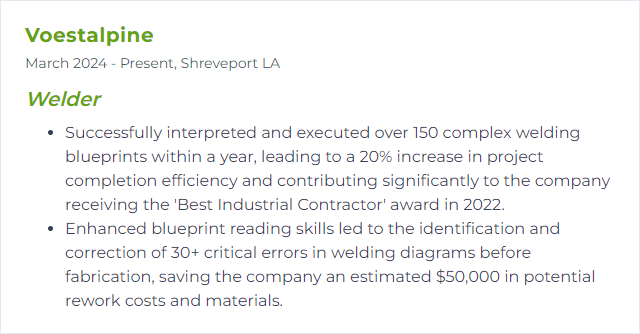
7. Precision Measuring
Precision measuring uses calipers, micrometers, gauges, and squares to verify dimensions before, during, and after welding. Small errors snowball. Tight checks stop that.
Why It's Important
Accurate parts fit the first time. Stronger assemblies, fewer defects, smoother inspections.
How to Improve Precision Measuring Skills
Choose the right tool for the tolerance. Calibrate instruments on schedule and store them carefully. Learn proper technique for consistent readings—same pressure, same alignment, same reference surface. Build simple checklists for critical dimensions. Track measurements and adjust process settings when drift appears.
How to Display Precision Measuring Skills on Your Resume
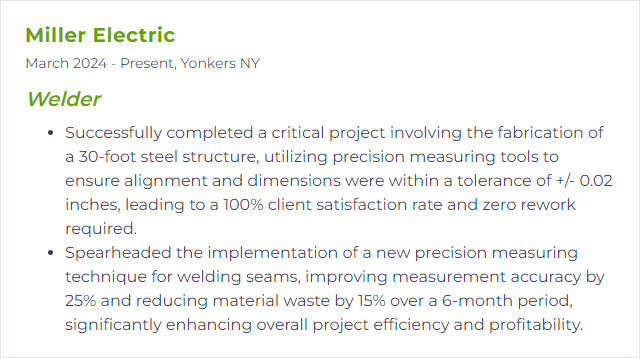
8. Metal Fabrication
Metal fabrication pulls together cutting, forming, fixturing, and welding to create parts and structures. From raw stock to finished build—end to end.
Why It's Important
It’s the backbone of real-world production. Knowing the whole flow lets you plan joints, minimize distortion, and hit deadlines.
How to Improve Metal Fabrication Skills
Refine core processes and keep certifications current. Use accurate jigs and fixtures to lock alignment. Plan weld sequences to control heat and shrink. Apply quality checks at each stage—fit-up, tack, root, fill, final. Stay aware of newer processes (laser, friction stir, advanced alloys) and choose tools that boost consistency and speed. Safety isn’t optional—treat it as part of the process plan.
How to Display Metal Fabrication Skills on Your Resume

9. Soldering
Soldering joins metals using a lower-melting filler without melting the base metal. Ideal for delicate parts, electronics, and thin materials where controlled heat rules.
Why It's Important
Not every joint needs a weld. Soldering handles precision assemblies and sensitive components that would warp under higher heat.
How to Improve Soldering Skills
Use quality solder and flux, and match them to the materials. Keep iron temperature in the right window for wetting without damage. Clean and tin the tip often. Heat the joint, not the solder, then feed just enough for a smooth fillet. Practice on scrap and inspect joints for shine, coverage, and strength.
How to Display Soldering Skills on Your Resume

10. Brazing
Brazing joins parts by melting a filler metal that flows into the joint by capillary action. The base metals don’t melt, which keeps distortion low and allows dissimilar metals to bond.
Why It's Important
Strong, sealed joints at lower temperatures. Great for assemblies that demand tight tolerances and clean appearance.
How to Improve Brazing Skills
Clean surfaces thoroughly and keep joint gaps tight (often around 0.001–0.003 inches). Select a filler compatible with base metals and service conditions. Apply heat evenly so the joint—not the filler—pulls the alloy through. Use flux when required and remove residues after cooling. Let parts cool naturally to limit stress. Inspect for full flow, proper fillet size, and void-free joints.
How to Display Brazing Skills on Your Resume
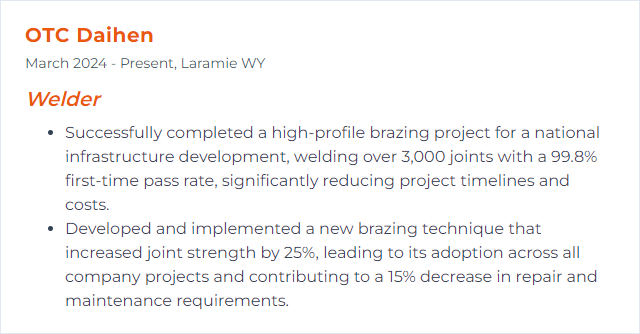
11. Oxy-Fuel Cutting
Oxy-fuel cutting uses oxygen and fuel gas to preheat steel and then oxidize a path through it. Tough plate? Portable setup? This process delivers.
Why It's Important
It’s reliable for thick carbon steel, edge prep, and demolition tasks. Field-ready and simple to maintain.
How to Improve Oxy-Fuel Cutting Skills
Choose the correct tip size and set pressures per material thickness. Preheat evenly until metal reaches kindling temperature. Move with a steady pace to maintain a continuous cut—too slow causes heavy slag; too fast leaves an incomplete kerf. Keep tips clean and check hoses, regulators, and valves regularly. Work with good ventilation and full PPE.
How to Display Oxy-Fuel Cutting Skills on Your Resume
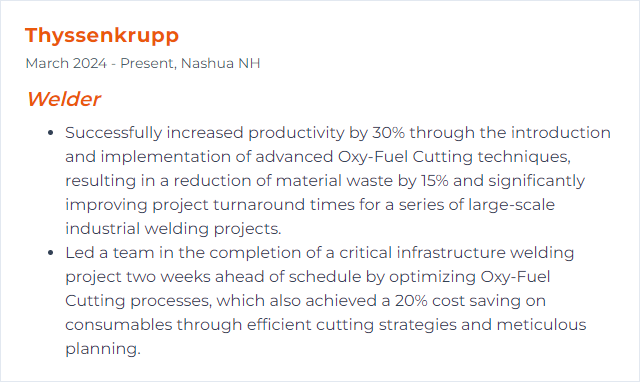
12. Safety Protocols
Safety for welders means correct PPE, ventilation, equipment checks, and hazard awareness at every step. Burns, UV, fumes, noise—control the risks before they control you.
Why It's Important
Protects health, prevents incidents, and keeps projects running. Safety is productivity, not paperwork.
How to Improve Safety Protocols Skills
Train regularly and refresh often. Use the right PPE for each process and maintain it. Ensure local exhaust or fume extraction fits the task. Inspect cables, torches, cylinders, and guards on a schedule. Label hot work areas and enforce clear walkways. Keep extinguishers close, establish emergency procedures, and practice them. Monitor air quality where needed and encourage reporting of near-misses to fix issues early.
How to Display Safety Protocols Skills on Your Resume
